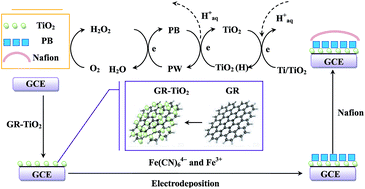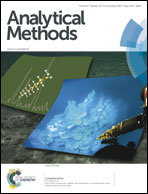Facile and controllable synthesis of Prussian blue nanocubes on TiO2–graphene composite nanosheets for nonenzymatic detection of hydrogen peroxide†
Abstract
A novel nonenzymatic sensor for hydrogen peroxide (H2O2) is developed based on a Nafion/Prussian blue/TiO2–graphene nanocomposite (Nafion/PB/TiO2–GR). The PB/TiO2–GR composite was prepared by the electrodeposition of PB nanocubes on the surface of TiO2–GR composite nanosheets and Nafion was used as a stabilizer. The Nafion/PB/TiO2–GR composite modified glassy carbon electrode (Nafion/PB/TiO2–GR/GCE) shows good electrocatalytic activity in the reduction of H2O2 and is used as an amperometric sensor. The sensor exhibits a linear response for H2O2 over concentrations ranging from 40 nM to 2 mM with a high sensitivity of 480.97 μA mM−1 cm−2 and a low detection limit (S/N = 3) of 8.6 nM. Additionally, the sensor exhibits long-term stability, good reproducibility and anti-interference. This study provides a new kind of nanocomposite modified electrode for electrochemical sensors.



 Please wait while we load your content...
Please wait while we load your content...